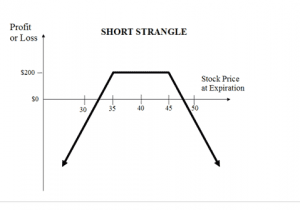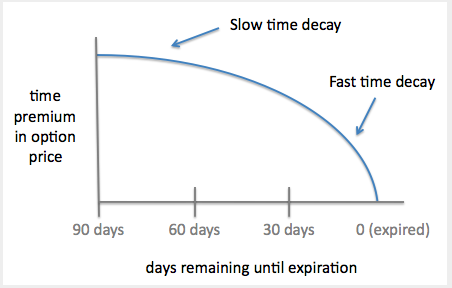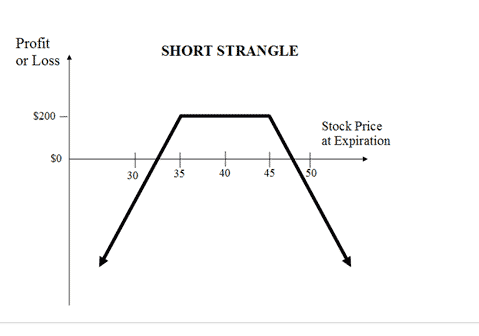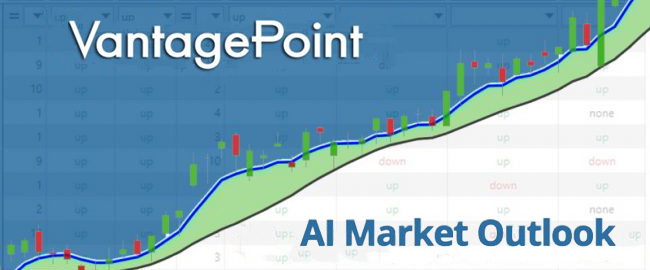Understanding Options: Trading Short Strangles
I was watching some Financial News shows the other day and was utterly baffled by the wide variety of contrasting opinions. One commentator was convinced the market was going to take off like a rocket ship “to the moon” while another financial expert was certain the market was going to crash.
Both commentators provided strong evidence for their starkly different perspectives. As I watched this heated debate, it became clear only three outcomes exist and the talking heads ALWAYS focus on only two of the possibilities.
- The Bull could be right.
- The Bear could be right.
- The Bull and Bear could both be wrong.
These three choices reinforce why options education is critically important for times like these. Most traders would know how to trade if they agreed with the bull or the bear. However, they would not know how to create a trade where both the bull and bear could be wrong.
Options are powerful tools that allow traders to create infinite possibilities than just being long or short the underlying asset. In this article I will discuss the SHORT STRANGLE options strategy which traders effectively use to create income over a very wide price range when the BULLS and BEARS could both be wrong in their assessment of the future.
The fastest way to understand Options Trading is to think of the insurance business. Quite literally, Options are price insurance.
All insurance contracts will insure you for a specific amount of coverage, for a specific amount of time. In exchange for this protection you will be required to pay a premium payment to the insurer.
Options, like insurance, are only good for a specified period of time. Therefore, they are deteriorating assets. All things being equal, an Option will be worth less tomorrow than it is today, simply because it is closer to the expiration date. However, if a great deal of uncertainty exists in the marketplace, Options prices will increase.
An Option is recognized as a deteriorating asset by savvy traders who use this understanding to create strategies that provide additional income to their portfolio while hopefully also minimizing risk.
A buyer of an Option has rights. To receive those rights, they will have to pay a premium payment to the Option seller.
A seller (creator) of an Option has obligations. They will be required to offset their position or fulfill their obligation if the market works against them.
Options trade similarly to the underlying asset and do not have to be held until expiration. They can be offset and liquidated at any time. This means they can be actively traded just like the underlying stock.
Traders often study trading tactics where large motion in the underlying stock is required for them to make money. Savvy Options traders recognize that when markets go neutral after a big move that lots of profit can be made by learning how to sell strangles and markets remain rangebound. Next time you look at a chart and you see a consistent trading range over an extended period of time, realize the strategies sellers of strangles have used to make more money selling Options than could be made trying to scalp the underlying stock.
The short strangle (selling strangles) strategy consists of selling an out-of-the-money put and call option on a stock in the same expiration cycle. Essentially the strategy is directionally neutral because it each side offsets the other side as long as the underlying stock/asset remains between the strike prices.
Here is an example with the risk and profit possibilities clearly delineated:

Selling Options Strangle Analysis
On this trade the underlying stock is trading at $40 per share.
This trader has SOLD 1 45 Call Option for 1 ($100), and
Simultaneously SOLD 1 35 Put for 1 ($100).
The Maximum Profitability if the amount of premium collected, which is $2 times 100 shares. This will occur at any price between 35 on the downside and 45 on the upside. In percentage terms this can be very attractive because in this example, the stock can move plus or minus 12% between now and the expiration date and the strangle seller will collect and keep 100% of the options premium.
The maximum profit is earned if the short strangle is held to expiration, if the stock price closes at or between the strike prices and both Options expire worthless.
The Maximum risk is theoretically unlimited on the upside, because the stock price can rise to infinity. On the downside, potential loss is substantial, because the stock price can fall to zero. To counter both of these risks, traders who trade short Options will often simply close out their position and liquidate should
the underlying stock price reach either strike price before expiration. In this example, the stock is trading at $40, if the stock were to trade at $45 or $35 the short strangle seller would simply liquidate their position and eliminate any further risk.
Breakeven stock price at expiration
There are two potential break-even points:
-
Higher strike price plus total premium:In this example: 45.00 + 2.00 = 47.00
-
Lower strike price minus total premium:In this example: 35.00 – 2.00 = 33.00
In other words, at any price between 33 on the downside and 47 on the upside this trade will make money.
This short strangle Options strategy works beautifully when the market goes from high volatility environment to lower volatility and remains in a narrower trading range. Strangles are often sold between earnings reports and other publicized announcements that have the potential to cause sharp stock price fluctuations. This tactic, while not necessarily suitable for beginners, is a favorite Options trade for many because it offsets the bullishness of of PermaBull with the Bearishness of a PermaBear. At its essence, the majority of the time the premiums will decline consistently going into expiration as long as neither strike price is breached.
“Selling strangles” is very appealing to many traders, because you collect two Option premiums, and the stock has to move ‘substantially’ before you lose money or are at risk. One of the best methods for determining the effectiveness of selling strangles is looking at a chart and measuring how often the underlying stock has moved a distance beyond the break-even points in the time remaining until the Options expiration.
For example, if the stock is trading at $35 and there are 15 days left until expiration how often has the stock moved 12 points, beyond 47 on the upside and $33 on the downside within a 15 day period of time? That analysis will provide a pretty good probability of how often this type of trade will be profitable.
Cement this concept into your subconscious trading mind:
It is not how much money you make when you are right that is important.
What IS Important is how little you lose when you are wrong.
The losing transactions in your trading career are the ones you need to study thoroughly. They are the trades that will allow you to learn and understand the nuances that differentiate great traders from wannabes.
Selling Options for income is one of the few strategies where you can be completely wrong about the direction of the market and still win. This is because an Option is a deteriorating asset and the premium will deteriorate exponentially the closer the Option is to the expiration date. By no means does this mean it is not risky. A seller of a put Option is obligating themselves to own the stock at the agreed upon short put strike price between now and the expiration date. The seller of a Call Option is obligating themselves to a short position at the agreed upon Call strike price between now and the expiration date.
This time decay of Option premium is best shown through the following chart:

This is a fairly simple way to profit from a neutral outlook, but there are substantial risks involved. My advice to traders is to always start out trading strangles in a demo account (paper trading) to familiarize yourself with the risks and rewards. This strategy will prove to be profitable better than 75% of the time. But for it to be workable you need to keep your losses small on the 25% of the time that it loses. My personal experience is that trading short strangles is like watching paint dry. The challenge of this tactic is that when either of the strike prices are breached it is very evident that you are not in a low volatility environment and the most prudent thing to do is take the small loss and move on.
Another huge benefit of this strategy is that the margin required to trade it will often be a very small percentage of what is required to own 100 shares of the underlying stock. As a comparison, if you purchased 100 shares of this stock at $35 a share you have to pay $3500. But the strangle seller will most brokerage platforms will often have to only put up $20% or less of that amount to be able to establish this position. This makes the maximum profit of $2 per share that much larger when you calculate your return on investment.
Here’s the secret to trading success in ONE simple sentence:
Manage your risk, or it will manage you!
Artificial Intelligence Is Your PERFECT Trading Partner
The incredible amount of data that computers can quickly compile and the machine learning that has evolved to let that data have meaning can work in your favor. Artificial Intelligence analyses the hidden patterns in our global markets without emotion and presents you with information that lets you manage your risk with far more accuracy than any human can give you.
A.I. can help you find Uptrends, Downtrends and Rangebound markets.
What is your guidance system to determine when it is safe to invest and when to move to the sidelines?
Technology has changed a lot in the last 50 years. Things like Artificial Intelligence, Machine Learning, and Neural Networks existed only in science fiction novels just a few decades ago.
Intrigued?
Visit with us and check out the a.i. at our Next Live Training.
Discover why artificial intelligence is the solution professional traders go-to for less risk, more rewards, and guaranteed peace of mind.
It’s not magic. It’s machine learning.
Make it count.











